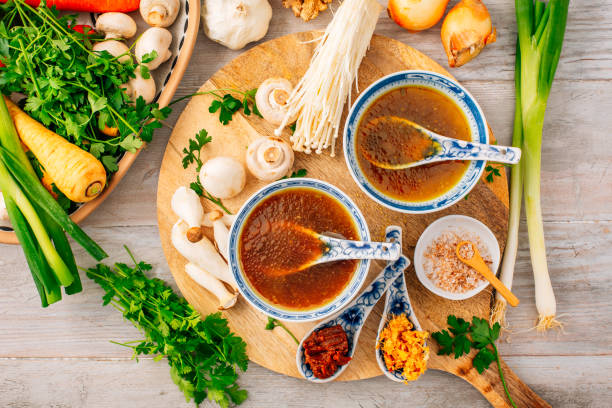Umami Alchemy: Crafting Flavor-Packed Broths
Unlock the secrets of umami-rich broths that transform ordinary meals into extraordinary culinary experiences. From ancient techniques to modern twists, discover how to create depth and complexity in your cooking. Join us on a journey through the world of savory, satisfying broths that will elevate your dishes and tantalize your taste buds.

Understanding the science behind umami allows home cooks to harness its power in their broths. Glutamates, inosinate, and guanylate are the primary umami-producing compounds. When combined, they create a synergistic effect, amplifying the overall umami taste. This is why combining ingredients like dried mushrooms, tomato paste, and aged cheeses in a broth can result in an explosion of flavor. By consciously incorporating umami-rich ingredients into your broths, you can create a more satisfying and complex taste profile that will elevate any dish it’s used in.
The Art of Bone Broth
Bone broth has been a staple in traditional cuisines for centuries, prized for its rich flavor and potential health benefits. The process of making bone broth involves simmering animal bones and connective tissues for an extended period, typically 12 to 24 hours. This slow cooking method extracts collagen, minerals, and amino acids from the bones, resulting in a gelatinous, nutrient-dense broth.
To create a flavorful bone broth, start with a mix of bones that include both meaty pieces and marrow-rich bones. Roasting the bones before simmering can add depth to the final product. Add aromatics like onions, garlic, and herbs to infuse additional flavors. A splash of apple cider vinegar helps extract minerals from the bones. Skimming off any impurities that rise to the surface during cooking ensures a clear, clean-tasting broth. The resulting liquid gold can be used as a base for soups, sauces, or simply enjoyed on its own as a nourishing beverage.
Vegetable Broth: A Plant-Based Powerhouse
Vegetable broth is a versatile and flavorful alternative to meat-based broths, perfect for vegetarians, vegans, or anyone looking to incorporate more plant-based options into their diet. The key to a rich vegetable broth lies in selecting a diverse array of vegetables and herbs that contribute different flavor profiles and nutritional benefits.
Start with a base of aromatic vegetables like onions, carrots, and celery. Add umami-rich ingredients such as mushrooms, tomatoes, and dried seaweed to enhance depth. Experiment with less common vegetables like fennel, parsnips, or leeks to create unique flavor combinations. Herbs and spices like thyme, bay leaves, and black peppercorns add complexity. Roasting the vegetables before simmering can intensify their flavors. Unlike bone broth, vegetable broth requires a shorter cooking time, typically 45 minutes to an hour, to extract maximum flavor without overcooking the vegetables.
Dashi: The Foundation of Japanese Cuisine
Dashi, the cornerstone of Japanese cooking, is a simple yet profoundly flavorful broth that exemplifies the essence of umami. Traditional dashi is made with just two ingredients: kombu (dried kelp) and katsuobushi (dried, fermented, and smoked bonito flakes). The result is a clear, subtly flavored broth that forms the base of many Japanese dishes, including miso soup, ramen, and various sauces.
To make classic dashi, start by soaking a piece of kombu in cold water for about 30 minutes. Slowly heat the water until it’s just about to boil, then remove the kombu. Add a handful of katsuobushi, let it steep for a few minutes, then strain. The entire process takes less than an hour but yields a broth with incredible depth. Variations of dashi include shiitake dashi, made with dried mushrooms, and vegetarian versions using only kombu. Understanding the principles of dashi-making opens up a world of possibilities for incorporating its unique umami flavor into both traditional and fusion cuisines.
Fusion Broths: Blending Culinary Traditions
As global culinary boundaries blur, innovative chefs and home cooks are experimenting with fusion broths that combine elements from different culinary traditions. These creative concoctions offer exciting new flavor profiles and often challenge our preconceptions about what a broth can be.
One example is the trendy bone broth ramen, which marries the rich, collagen-packed broth of Western bone broth with the aromatic complexity of Japanese ramen. Another fusion favorite is the Thai-inspired coconut curry broth, which blends the creaminess of coconut milk with the bold spices of curry and the umami punch of fish sauce or mushrooms. For a Mediterranean twist, try a broth infused with roasted garlic, sun-dried tomatoes, and herbs like rosemary and thyme. The key to successful fusion broths is balancing flavors and respecting the culinary traditions you’re drawing from while not being afraid to push boundaries and create something truly unique.
Useful Tips & Facts
• Use a pressure cooker to make bone broth in a fraction of the time without sacrificing flavor.
• Save vegetable scraps in the freezer to make flavorful vegetable broth.
• Miso paste can be added to any broth for an instant umami boost.
• Dried mushrooms like porcini or shiitake are umami powerhouses in broths.
• Experiment with different types of seaweed beyond kombu for unique flavors in dashi.
• Parmesan cheese rinds add depth to vegetable broths.
• Roasting bones or vegetables before making broth intensifies flavors.
• Use ice cube trays to freeze small portions of broth for easy use in recipes.
Conclusion
Mastering the art of umami-rich broths opens up a world of culinary possibilities. Whether you’re simmering bones for hours, crafting a quick vegetable broth, or experimenting with fusion flavors, the principles of extracting and balancing umami remain key. As you explore different broth-making techniques, you’ll develop a deeper appreciation for the complexity of flavors and the ways in which a well-crafted broth can elevate even the simplest of dishes. So, grab your biggest pot, gather your ingredients, and embark on your own broth-making adventure. Your taste buds—and your cooking—will never be the same.





